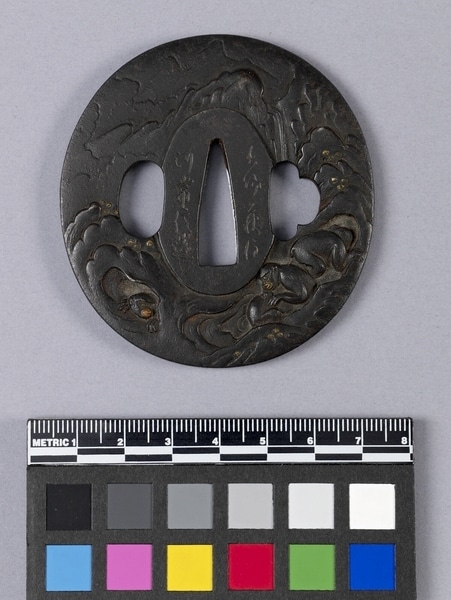Sword Guard Item Number: Ed5.3151 from the MOA: University of British Columbia


Description
Oval-shaped metal sword guard with triangular hole at centre, three-lobed hole to one side, and ovoid hole to the other side. Low relief design of landscape with monkeys in mountain caves at bottom on face, and one monkey in a mountain cave with only head and arm showing on reverse. Copper and gold inlaid elements ? in design. Signed on seppa dai; open kodzuka and kogai.
History Of Use
Tsuba are placed between the hilt and blade of a sword, forming an essential guard for the hand. Known to exist in Japan at least since the 8th century, they were plain unsigned metal until about the 16th century, when they became enriched artistic expressions usually made to the order of the individual warrior. The central opening, nakago ana, holds the tang of the blade and often has chisel marks or soft metal inserts as adjustments. It is surrounded by a plain surface, the seppa dai, on which the artist's signature may be found. On either side are the kodzuka and kogai openings, for a knife and a skewer respectively; when both are open the guard is intended for a wakazashi blade (less than two feet) and when one or both are plugged or absent the guard is probably intended for the longer katana blade.
Narrative
Marion Stephan Collection. 'Iron' strictly speaking is a pure metal never encountered in antiquity; its alloys, whether natural or deliberate are really forms of steel. There is a long tradition in the literature, however, of referring to the material of a major number of tsuba as iron, which is adhered to in the present catalogue. This tsuba belongs to the school of the Chosu armourers.
Item History
- Made in Nagato, Japan between 1810 and 1830
- Collected between 1935 and 1940
- Owned by Marion Stephan
- Owned by Charles H. Stephan before January 10, 1977
- Received from Charles H. Stephan (Donor) on January 10, 1977
What
- Name
- Sword Guard
- Identification Number
- Ed5.3151
- Type of Item
- guard
- Material
- iron metal and copper metal
- Manufacturing Technique
- inlaid and forged
- Overall
- height 0.4 cm, diameter 7.0 cm
Who
- Culture
- Japanese
- Previous Owner
- Marion Stephan and Charles H. Stephan
- Received from
- Charles H. Stephan (Donor)
Where
- Holding Institution
- MOA: University of British Columbia
- Made in
- Nagato, Japan
When
- Creation Date
- between 1810 and 1830
- Collection Date
- between 1935 and 1940
- Ownership Date
- before January 10, 1977
- Acquisition Date
- on January 10, 1977
Other
- Item Classes
- metalwork
- Condition
- good
- Current Location
- Case 79
- Accession Number
- 0352/0273